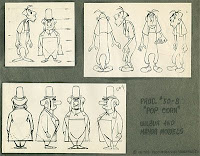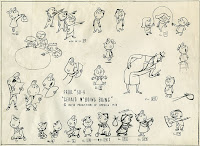United
Productions of America, also known as UPA, started as a small studio that
created industrial shorts during World War II. It was established by former
Disney vets John Hobley, Zack Schwartz,
Dave Hilberman and Steve Bosustow. The
40s were a rough time for Disney as World War II cut off foreign markets. The
studio began to grow to quickly resulting in a different vibe and a change in
the factory environment. Eventually the animators went on strike not only for
the working conditions, but because they felt as though the animation
techniques were too basic. The studio’s approach was too realistic and the
animated films resembled to closely of live action (to an extent). After the
strike, many animators left Disney for a chance to do something new and
different.
 |
| Schwartz, Hilberman & Bosustow discuss the storyboard for their first industrial slide film "Sparks & Chips Get the Blitz" |
Realism vs. Limited Animation
UPA’s
style of animation is called limited animation. This style was implemented as a
cost-cutting approach rather than an artistic choice. Instead of redrawing
entire frames, this style reuses common frames. Any animation that uses limited
animation creates an image that has fewer drawings, symbolism, and abstract art
which all creates the same effect but at a much lower cost.
Instead of 24 frames per second, UPA used 12 frames per second, which provided fewer drawings used to make animation effects. This time saving technique does not lower quality of animations but it helps it flow smoother. This style was established by UPA since they wanted to discard the style that Disney created. They wanted to be able to be more graphic and experimental in the design of the characters, making them look like characters and not realistic. The benefits of this were that it allowed a large amount of savings for production costs. This is where the beginning of television animation began. Simpler drawings became a staple of TV animation and are still seen in animation series today.
Instead of 24 frames per second, UPA used 12 frames per second, which provided fewer drawings used to make animation effects. This time saving technique does not lower quality of animations but it helps it flow smoother. This style was established by UPA since they wanted to discard the style that Disney created. They wanted to be able to be more graphic and experimental in the design of the characters, making them look like characters and not realistic. The benefits of this were that it allowed a large amount of savings for production costs. This is where the beginning of television animation began. Simpler drawings became a staple of TV animation and are still seen in animation series today.
At the end of the war, UPA was uncertain of what the next steps might be considering most of their productions were war propaganda. At the same time, Columbia Pictures was unhappy with their short films and was looking for something new. The two partnered agreeing to produce entertainment cartoons. After partnering with Columbia, UPA truly began their unique journey into the animation world. Their first short,
“Robin Hoodlum” was nominated for an Academy Award for Best Animated Short Subject. UPA began to release shorts that no other studio has seen before. The Tell-Tale Heart and Rooty Toot Toot are examples of early works that contained these designs that no other studio has done before. As UPA began to release shorts, the more popular each of them grew.
The unique style and techniques that were used at UPA were recognizable as many other animation studios began to copy the ideas. In order to making their animations actually look as if they were animations, UPA created two rules regarding their shorts, “no talking animals and no “cartoon violence” (Abraham). UPA was well known for their layouts and backgrounds, using bold graphics, bright colors, odd spacing and having a flat look to them.
Many
of the stylistic techniques that UPA practiced can be viewed. Since no talking
animals were allowed, UPA created the first human character in animation, wanting
to experiment with animation and personalities.
Mr. Magoo, has a personality is anything but ordinary and behaved as a real human, not a character that gets smashed, stretched, sliced, blown up or anything to the extreme. Magoo’s personality changes throughout the series, starting as nasty old many and turning into a more loveable character. The style of the series was very dark and angular and the pacing was slow and thought out more carefully. Mr. Magoo is notable for its Oscar achievements by winning two Academy Awards for Best Short Subject (Cartoons) for When Magoo Flew (1955) and Magoo’s Puddle Jumper(1956). Due to the success of Magoo, the studio decided to product its first feature length film staring Mr. Magoo.
1001 Arabian Nights was released in 1959 and has a very similar story line to Disney’s 1992 feature Aladdin. Even though the film produced large merchandise sales and Mr. Magoo participated as a spokesperson in many commercial campaigns, the film was not a success and is not remembered. With the film being a flop, UPA started to spend more time on producing cartoons for television and within 2 years had 130 episodes. For 40 years, Mr. Magoo has been able to keep the audience entertained for as long as he did because of his personality.

 Another
popular character, Gerald McBoing Boing is part of the Jolly Frolics series and
was the first successful theatrical cartoon produced by UPA, winning the 1950
Academy Award for Best Animated Short. Because of how fast the cartoons
came out, it affected the quality of the cartoons. Gerald McBoing Boing, which was
originally a short film and later produced into a television series, has a lot
of personality and displays the approach that UPA was after. With its bright
colors and bare background, Gerald McBoing Boing received reviews from critics
stating that the animation is a drawing and not realistic, which was exactly
what UPA wanted to accomplish. It was their first attempt and a major step to
really break away from the strict realism that was seen in animation at the
time.
Another
popular character, Gerald McBoing Boing is part of the Jolly Frolics series and
was the first successful theatrical cartoon produced by UPA, winning the 1950
Academy Award for Best Animated Short. Because of how fast the cartoons
came out, it affected the quality of the cartoons. Gerald McBoing Boing, which was
originally a short film and later produced into a television series, has a lot
of personality and displays the approach that UPA was after. With its bright
colors and bare background, Gerald McBoing Boing received reviews from critics
stating that the animation is a drawing and not realistic, which was exactly
what UPA wanted to accomplish. It was their first attempt and a major step to
really break away from the strict realism that was seen in animation at the
time. 
With the failure of their first feature film but the success of Mr. Magoo
and Gerald McBoing Boing as character, UPA decided to begin producing
television series in 1955. By 1956, The Gerald McBoing Boing Show premiered
offering an array of different styles from many animators. Unfortunately, the
audiences did not find television animation entertaining to the point where the
show was taken off the air. From 1950-1960, many Hollywood studios began to cut
back on spending for shorts, which resulted in UPA struggling financially. In
order to not go out of business, UPA focused on producing successful television
animation by releasing cartoons at a much faster pace then they have ever
before.
in 1962, which was the second and final feature for the studio. Similarly to 1001 Arabian Nights, after the release they received low box office numbers and indifferent reviews about the film. That same year, UPA released Mr. Magoo’s Christmas Carol, which was the first, animated holiday show that was specifically produced to be shown on television. The animation received great reviews and is considered, even to this day, to be a holiday classic.
After
1962, the studio slowly began to stop producing original animation and sold off
their library of cartoons, keeping licenses and copyrights on Mr. Magoo, Gerald
McBoing Boing and other UPA characters. Columbia Pictures retained ownership of
UPA’s theatrical cartoons and UPA was eventually led into a contract with Toho
Studios of Japan. By 1970, UPA’s animation production was officially shut down
which ended an era that changed the face of animation.
Work Cited
Abraham, A. (n.d.). History, from http://www.upapix.com/History.html
Cawley, J., & Korkis, J. (n.d.).
Mr. Magoo. Retrieved from http://www.cataroo.com/cst_MAGOO.html
UPA. (n.d.). Retrieved from http://www.vegalleries.com/upa.html
UPA (United Productions of America)
Studio Directory @ BCDB. (n.d.)., from http://www.bcdb.com/cartoons/Columbia_Pictures/UPA/
United Productions of America (UPA).
(n.d.). Retrieved from http://www.toonopedia.com/upa.htm









































